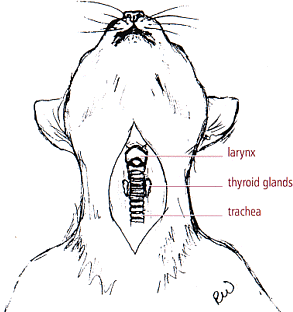Understanding Your Cat's Hyperthyroidism
Hyperthyroidism is a common albeit unpleasant condition known to many humans, especially females. It is also very common in cats. Although the term may be well known, many pet owners may not fully understand hyperthyroidism or its complications. This article hopes to dispel some of the condition's mysteries and provide a brief outline of the condition's basic elements.
 Where is My Cat's Thyroid Gland?
Where is My Cat's Thyroid Gland?
Actually, your feline friend has two thyroid glands- one located on either side of its windpipe. Although a normal thyroid gland is small in size, it has a large responsibility for your cat's metabolic function. The gland regulates the speed of all chemical reactions in your cat's body. In other words, it steers your pet's basic metabolic rate and produces a hormone called thyroxine. This hormone regulates how quickly your cat's metabolism functions and, consequently, how quickly it burns calories. When the gland malfunctions so, too, does the hormonal flow of thyroxin and your pet suddenly falls victim to hyperthyroidism.
To Worry or Not to Worry?
As a pet owner, that is always the question. Hyperthyroidism is very common in cats, particularly aging cats. It is also more common in females than males. Why occasionally hyperthyroid cats can also develop malignant thyroid tumors, this is quite rare. In general, a cat suffering from this condition is simply producing too much thyroxin, which is interrupting its normal metabolic rate. As a result, these cats experience weight loss, increased appetite, activity and restlessness, accelerated heart rate, poor hair coat, intestinal distress among other symptoms.
Although hyperthyroidism is very common in cats, this does not imply that it should be ignored. Hyperthyroidism can have lasting effects on your cat's kidneys, liver, heart and blood pressure.
If your veterinarian is suspicious that your cat might have hyperthyroidism, he/she will order a T-4 blood test. If T-4 levels in your cat are markedly higher than they should be for its age group, a hyperthyroid diagnosis is the most probable diagnosis. Remedies and relief can be found in medicines, surgery or radiological treatment options. For the best treatment for your cat, contact your veterinarian and explore the many treatment methods available to your feline friend.